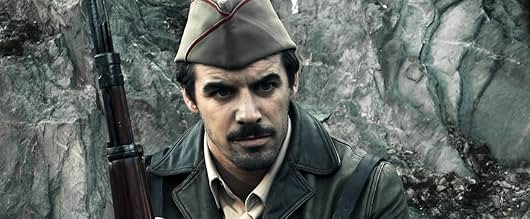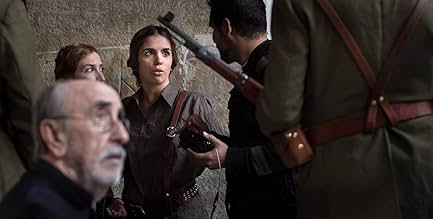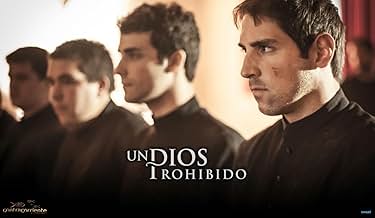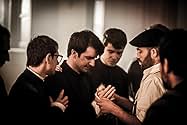अपनी भाषा में प्लॉट जोड़ेंAugust 1936, the beginning of the Spanish Civil War. 51 members of the Claretian community of Barbastro (Huesca) are martyred, die for their faith. The film recounts the last weeks of his li... सभी पढ़ेंAugust 1936, the beginning of the Spanish Civil War. 51 members of the Claretian community of Barbastro (Huesca) are martyred, die for their faith. The film recounts the last weeks of his life, since they are held until they are finally shot. During that time, they perform variou... सभी पढ़ेंAugust 1936, the beginning of the Spanish Civil War. 51 members of the Claretian community of Barbastro (Huesca) are martyred, die for their faith. The film recounts the last weeks of his life, since they are held until they are finally shot. During that time, they perform various writings they talk about their situation, of his fellow captives, people who saw them. T... सभी पढ़ें
- Juan Echarri
- (as Álex Domínguez)
- Padre Masferrer
- (as Daniel Gómez)
कहानी
This is a very interesting and thought-provoking film , though overlong , dealing with historical events occurred on 20 July 1936 in the little town of Barbastro in Huesca . It recounts a great story about forgiveness and holy love . Brotherhood and fraternity sense are essential because the young priests are over 20 years living a community experience that help and unite themselves . Loyalties among them as a perfect community as well as an ideal , as their religious vocation as missionaries . In addition , forgiveness is something that weighs heavily in the film . As a group of people that stay true to what they love coming to the end of the consequences , performing a life entirely consistent and highlighting to love God before death . The picture displays nice acting with a good cast , though unknown , exception for Elena Furiase , Lolita Flores's daughter , and special appearance by veteran Jesus Guzman, unforgettable postman of Cronicas De Un Pueblo . Cinematography is colorful and adequate . Production design and sets are appropriate , being filmed on location in Barbastro . Atmospheric and sensitive musical score composed by synthesizer .
In 2012 took place in Madrid a first agreement between the Claretian Missionaries and 'Contracorriente Productions' to finance this good film. Contracorriente Producciones S. L. U., founded in 2006 has produced other films of religious genre, such as : ¨Alba" (2011) "Pablo de Tarso¨, ¨Ultimo Viaje (2009) y "Talita Kum" (2007) . The film director, Pablo Moreno, told that has been "a risky project , as being the Spanish Civil War a subject to be treated with extreme delicacy not to fall into Manichaeism history , neither a story about good and bad guys , as the screenplay is faithfully based on the historical deeds" .
The facts were the following ones : The day of the military coup on 17 July 1936, in the city of Barbastro , a serene location but in tension . The Claretian missionaries , mostly young students, trust the words of tranquility by the military chief , Colonel Villalba . However , at 17.30 hours on 20 July 1936 about sixty communists and anarchists of the CNT , FAI and armed militiamen stormed the community in which they resided as missionaries , which consisted of 60 people : nine priests , twelve brothers and 39 students . The top three priests were arrested while the rest were taken and held in a hall of the college of Escolapios , which became a makeshift prison . The guards looked over and over the apostasy of young seminarians , were forbidden to pray and introducing prostitutes to entice them , but without success . During the closure , the young left their testimony on chairs , tables , walls and even the food wrappers , even on a chocolate wrap a tragic testimony was written by seminarian Faustino Pérez . These writings have been the basic testimony used to narrate this real fact in film version . Twelve days after being jailed , senior priests were executed . The rest would be on 12, 13, 15 and 18 August 1936 . With them died a gypsy , Ceferino Giménez, who refused to leave her rosary, Pele , as he was known, was also beatified by the Catholic Church . Two Argentine seminarians surnamed Parussini and Hall were transmitters the moments of suffering to which they were submitted , as they were released a few days before the shootings . Monsignor Bishop Florentino Asensio was arrested in Barbastro during the events, and imprisoned, being transferred on August 8, 1936 the City Council to a cell . There he was submitted to all kinds of humiliating , tortures , amputation and after that , throwing him in the mass grave . Some simple monuments recall the places of martyrdom, and their remains rest in the crypt of the House-Museum of the Claretian Barbastro. On October 25, 1992 Pope Juan Pablo II beatified the Barbastro Martyrs .
टॉप पसंद
विवरण
बॉक्स ऑफ़िस
- बजट
- €2,50,000(अनुमानित)
- दुनिया भर में सकल
- $3,37,956
- चलने की अवधि2 घंटे 13 मिनट
- रंग
- पक्ष अनुपात
- 2.35 : 1
इस पेज में योगदान दें















